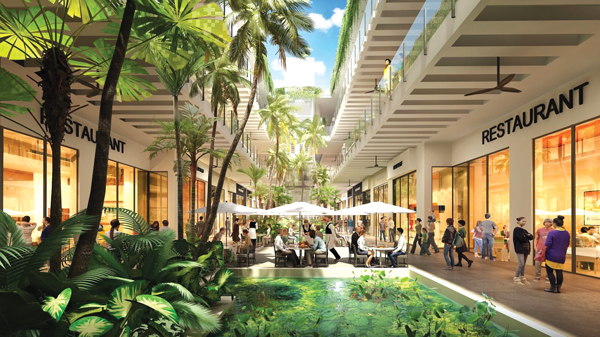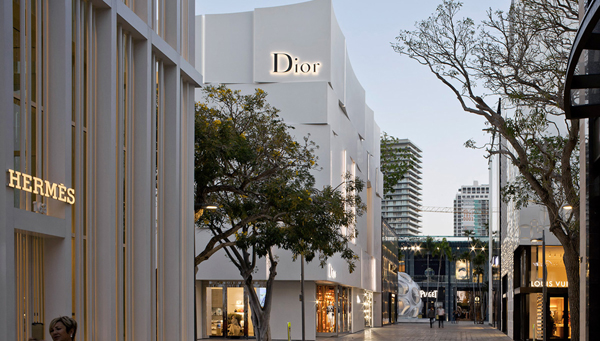Trending
Luxury retail’s battle royale

When construction begins later this year at the Bal Harbour Shops, it will mark the first time in three and a half decades that the luxury mall’s owners will expand its footprint. Whitman Family Development, which owns Bal Harbour Shops, is adding more than 340,000 square feet to the center’s existing 450,000 square feet of retail space, and the new area is going to be anchored by the first Barneys New York in Florida.
For boosters of the ritzy shopping center, landing Barneys is a testament to the drawing power that Bal Harbour Shops still wields in the fickle luxury retail market. For skeptics, the long-delayed update is proof that the Whitman family needed a bold move to stave off the rising fortunes of Aventura Mall and the Design District, two tourist-driven retail destinations that have poached some of Bal Harbour Shops’ big-name luxury tenants in recent years.
“Bal Harbour Shops still stands as the gold standard in luxury retail in South Florida,” said Rafael Romero, a vice president with commercial brokerage CREC. “There are more luxury retail projects, but at the end of the day, it is very challenging for these new players to trump Bal Harbour Shops.”
Some hard data backs up Romero’s assertions. According to Green Street Advisors’ 2016 report on the top 10 malls in the U.S. by sales — the most recent available — Bal Harbour Shops took the number one spot. The 520,000-square-foot shopping center had $3,185 in sales per square foot. Aventura Mall, which came in fifth, made $1,595 in sales per square foot with 2.1 million square feet of retail space.
However, Bal Harbour Shops’ long reign as South Florida’s crown jewel of luxury retail is in peril. Aventura Mall’s owners, Turnberry Associates, recently opened a $214 million new wing, which features 315,000 square feet of shops, restaurants and an interactive, nine-story Carsten Höller sculpture with two slides people can ride down. Before the expansion, Turnberry had also convinced Louis Vuitton, Gucci and Givenchy, among others, to plant flagships at Aventura Mall.
Matt Levinson, a Turnberry spokesman, said the company sells tenants on Aventura Mall’s popularity by noting that it draws more than 29 million visitors each year and ranks as the sixth most visited destination in Miami-Dade by the Greater Miami Convention and Visitors Bureau.
“The breadth of Aventura Mall’s offerings is unrivaled,” Levinson said. “Aventura Mall also offers wide-ranging programming and experiences that drive engagement with locals as well as international visitors.”
Levinson declined to say if Turnberry offers luxury retailers lease incentives to open storefronts in Aventura Mall.
Although the Design District didn’t crack Green Street’s 2016 top 10, it potentially poses the biggest threat to Bal Harbour Shops’ supremacy, thanks to commitments made five years ago by the world’s most famous high-fashion brands — including Louis Vuitton, Tom Ford and Givenchy — to anchor the once-gritty-now-glam neighborhood.
 “All those tenants understand why it is important to put flagships in the urban core,” said Tony Arellano, a principal with DWNTWN Realty Advisors. “Some people would argue the Design District, over time, will grow into a better location, in terms of density, than Bal Harbour Shops.”
“All those tenants understand why it is important to put flagships in the urban core,” said Tony Arellano, a principal with DWNTWN Realty Advisors. “Some people would argue the Design District, over time, will grow into a better location, in terms of density, than Bal Harbour Shops.”
Matthew Whitman Lazenby, CEO of Whitman Family Development, acknowledged that Bal Harbour Shops needed a jolt to meet the demands of Miami’s growing luxury retail market.
The expansion will go a long way to solidifying Bal Harbour Shops’ grip as the region’s top luxury retail destination, Lazenby said. “We were well overdue for an adjustment,” he said. “Not having enough space has resulted in a long list of potential tenants we can’t accommodate and others that are already here in spaces that are way too small for them.”
Indeed, it was the Whitman family’s inability to give a high-profile tenant more space that led to a mass exodus of retailers to the Design District. In 2013, Bal Harbour Shops could not accommodate Louis Vuitton parent company LVMH’s demands to expand its Louis Vuitton flagship store due to lack of available space. Compounding the problem was a radius clause that stipulated that if tenants opened stores in other parts of South Florida, they would have to pay percentages of their sales from the other locations to Whitman Family Development.
From that impasse, the Design District emerged as a spoiler to Bal Harbour Shops’ dominance in the South Florida market. Miami developer Craig Robins’ company, Dacra, which owns a significant number of properties in the Design District, inked a 50-50 partnership with L Real Estate, of which LVMH is a majority shareholder. The deal involved transforming the Design District into a luxury retail destination largely fueled by the relocation of Louis Vuitton and other LVMH brands from Bal Harbour Shops. Other big names such as Bulgari, Burberry, Christian Dior, Fendi, Tom Ford and Zegna followed Louis Vuitton to the Design District.
The Dacra and L Real Estate partnership, which also includes investors General Growth Properties and Ashkenazy Acquisition Corp., formed Miami Design District Associates, which owns roughly 70 percent of the privately owned properties in the neighborhood. Currently, 1 million square feet of space is under development, and Miami Design District Associates has development rights to another 1.5 to 2 million square feet.
In late November, the partnership completed the second phase of redevelopment with the opening of Paradise Plaza, a two-story, open-air retail center at 151 Northeast 41st Street. Its luxury client roster includes Cynthia Rowley, Dolce & Gabbana, Gucci and Rag & Bone. The Institute of Contemporary Art also opened its new 37,500-square-foot home about a block north, at 61 Northeast 41st Street.
In turn, the Design District’s revamp has brought in other investors, including Brooklyn-based Redsky Capital, London-based JZ Capital Partners, New York-based Helm Equities, the Gindi family, Thor Equities and David Edelstein’s TriStar Capital.
Dacra vice president Anna Williams said that Miami Design District Associates’ first two phases are 98 percent occupied and that retail space for the third phase should be leased up within the next six months.
The Design District offers potential tenants a bona fide neighborhood teeming with creativity, culture and cache, Williams said. “Brands have almost no constraints on what they can do, in terms of size,” she said. “Where else could Hermès have 10,000 square feet to make a creative statement? We also are the only destination with almost all of the important luxury brands. We believe those factors combine to create a context for true flagship stores.”

About 98 percent of the space redeveloped by Miami Design District Associates has been leased, the company said.
There are no deal sweeteners or incentives offered to potential tenants of the Design District, Williams said.
Still, Michael Comras, founder and CEO of the Comras Company, said the Design District is experiencing growing pains, as the neighborhood has not yet hit critical mass. Comras’ firm handles leasing for Atlas Plaza, a Design District shopping center located at 130 Northeast 40th Street owned by TriStar Capital and RFR Holdings.
“It is very challenging to take an urban district like this and merchandise it effectively and create an environment people want to visit,” Comras said. “When you have pre-existing buildings and different landlords, it won’t happen in one fell swoop.”
New tenants leasing storefronts in Atlas Plaza over the past 12 months include designer eyewear maker Oliver Peoples, international cosmetics brand Sisley and high-end womens’ apparel store Lauren Moshi. Comras said the grand opening of Paradise Plaza has led to a rise in foot traffic since mid-December.
The increasing draw of the Design District and the Aventura Mall are changing the dynamics of Miami’s luxury retail market, forcing Bal Harbour Shops to shy away from radius clauses in tenant contracts. “The reality is Miami-Dade is not the Miami-Dade from 1965 when we first opened,” Lazenby said. “We still value the notion of exclusivity, but we’re not forcing tenants not to have other locations in our trade area.”
In addition to expanding the mall, the Whitmans partnered with Swire Properties and Simon Property Group to program the retail at Brickell City Centre, the massive $1 billion mixed-use development in Miami’s financial district.
Whitman Family Development continues to cultivate its tenant mix, said Courtney Lord, the company’s vice-president of leasing. “Rather than wait for brokers to come to us, we go into the international market and find those that we think would be a welcome addition,” Lord said.
This approach has allowed Bal Harbour Shops to introduce Italian suit maker Cesare Attolini, sunglasses designer Linda Farrow and womenswear designer Marie France Van Damme to South Florida. Leather goods maker Valextra and French fashion house Balmain are on the list of tenants that will open at the shopping center soon. In addition, Valentino, Salvatore Ferragamo and Saint Laurent recently grew from one-level boutiques to two-level bazaars there.
In the past two years, the shopping center fought hard to win approval from the Bal Harbour Village Council to expand the center. “There is an intimacy in our scale that we don’t ever want to lose,” Lazenby said. “But this expansion is going to provide the supply to meet our current demand for space.”
By refreshing Bal Harbour Shops’ architecture and recruiting brands with zero Florida presence, the Whitman family is able to generate new excitement for the shopping center, said CREC’s Romero.
“It serves as the ultimate statement that Bal Harbour Shops continues to be dominant in this market,” Romero said. “When it comes to an established name that is recognized worldwide, Bal Harbour Shops has yet to be beaten in that category.”
Lazenby also holds on to the possibility that the expansion may lure a few of the top names that resettled in the Design District back to Bal Harbour Shops.
“We believe now, as we did then, that we would be better off if they were still here,” Lazenby said. “We hope one day, they will return.”




